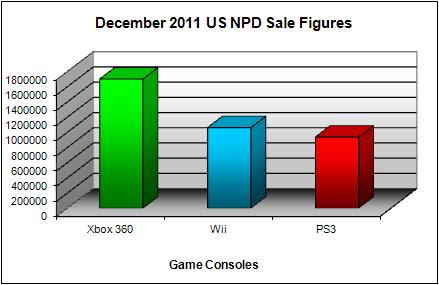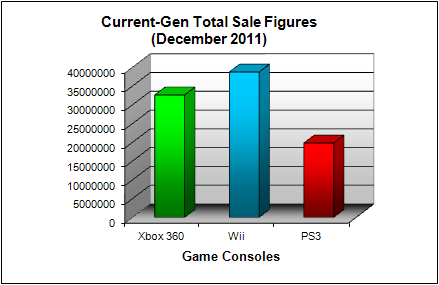Welcome to the December 2011 edition of our regular NPD US video game sales analysis. In this feature, we look at video game sales, both hardware and software, for the month of December 2011 based on data collected by the NPD. December is traditionally the most important period of the year, where a huge percentage of the entire year’s sales occur. And as a result, there is no month more important than December, and it’s a great way to gauge the general state of the video gaming industry. Last year, the Wii has the holiday time winner, easily beating the Xbox 360, and 12 month is a long time for a game console. Read on the find out if the Wii continued its tradition of holiday success, and whether the industry as a whole had a good holiday period. Or not.
As NPD no longer releases full hardware sales figures, this feature is reliant on the game companies, namely Microsoft, Nintendo and Sony, to release their set of figures and based on “statement math” (that is, arithmetically calculate missing figures based on statements made). For December 2011, these are the statements made by the gaming companies:
- Nintendo did not reveal any figures for December 2011
- Microsoft revealed “more than” 1.7 million Xbox 360 hardware units sold, with 46% of the home based console market share (source)
- Sony did not reveal any figures for December 2011
With only the above information, it becomes impossible to work out the estimated numbers for both the Wii and the PS3. Luckily, analyst Michael Pachter again came to the rescue, via Twitter, stating the Wii sales were in fact 55% down from the same month a year ago. With this piece of crucial information, we are then able to deduce the Wii numbers, and from this and the 46% market share figure quoted by Microsoft, we are then able to estimate the PS3 numbers too.
And so the figures for US sales in December 2011 are below, ranked in order of number of sales (December 2010 figures also shown, including percentage change):
- Xbox 360: 1,700,000 (Total: 30.9 million; December 2010: 1,860,000 – down 8.6%)
- Wii: 1,060,000 (Total: 37.7 million; December 2010: 2,360,000 – down 55%)
- PS3: 936,000 (Total: 18.9 million; December 2010: 1,210,000 – down 22.6%)
My prediction from last month was:
Same hardware ordering, and a software chart that looks very similar to this month’s, so there’s nothing much to add to that really.
While the software chart has a lot of titles that were there in November, the hardware ordering actually changed, with the PS3 dropping back down to third place, after finishing above the Wii last month.
Overall, looking at the figures above, and the “sea of red”, December 2011 has been nothing short of a disastrous month for video game sales, especially compared to last December. As mentioned earlier, a huge percentage of sales occur in December, but this last particular December did not even out do the previous month, when historically, this has almost always been the case. In fact, for hardware sales, the raw numbers were at its lowest since 2005.
Microsoft was probably the “winner”, if you can call it that (more like the smallest loser), with only an 8.6% drop in console sales, and level in sales with November. The NPD pointed to the strength of the Xbox 360 throughout the year, saying that the Xbox 360 platform accounted for nearly 40% of annual physical retail sales, across all categories. Still, if you count November and December together as one period, then 2011 has been good to the Xbox 360, with 3.4 million consoles sold, compared to 3.23 million a year ago. Microsoft probably had hoped the Kinect Star Wars game and console bundle would have made it in time, helping to push the console, and Kinect, to the next level, but the delay to the game means that there were no real A-list Kinect titles for this holiday period (unless you count Kinect Sports 2, and Dance Central 2, as A-list titles).
Despite finishing as the third most popular console, the PS3 was probably in second place overall, when you look at the year-to-year decrease figure, as well as performances across both November and December. Nearly 1.84 million PS3 consoles were sold during November and December, compared to 1.74 million consoles in 2011. So the good news is that, things are not that bad, while the bad news is that, the Xbox 360 appears to be pulling further ahead in the United States, where during the same period, it had almost twice as many sales (and more console sales during the holiday period, means more game sales for the rest of next year, and also means a strengthening multiplayer community, the growth of which relies on people using the same console as their friends).
So the real loser is, once again, Nintendo. The Wii, previously the unstoppable juggernaut during December sales, is no more, and is relegated to a distant second place behind the Xbox 360. For November and December, 1.92 million Wiis were sold, compared to 3.63 million in 2010 – in fact, more Wiis were sold in December of 2010 alone, than November an December of 2011 combined! A 55% year-on-year drop shows that the Wii is no longer the “must-have” video game gift, with some of the sales going to the Xbox 360 (not many, looking at the figures above), and possibly lots of sales going to things like tablets and smartphones, the new home of casual gaming.
And that’s probably the best way to look at things for the video game industry as a whole, for the most recent holiday period. The industry has benefited from the Wii becoming a must-have gift item for the last several holiday periods. Kinect has contributed to the same phenomenon, but it just hasn’t been the same. And with so many other gadgets to distract the holiday shopper, and also the economy, the decline can almost been seen as a return to normal, after a couple of years of extraordinary performance led by the Wii. Maybe the Wii U will bring back the same thing next year, but expectations must be readjusted.
As for software sales, it was also down compared to December 2010. MW3 led the chart again, with Skyrim dropping to third after the resurgence of Just Dance 3. Interestingly, looking at total sales for 2011, the ordering of the top 3 was exactly the same as the December top 3, showing that Call of Duty, and perhaps surprisingly, Just Dance, were the top 2 franchises for 2011. Mario Kart 7 on the 3DS was the only new entry into the top 10 in December. Here’s the full software sales chart for December (new releases for December 2011 in bold):
- Call of Duty: Modern Warfare 3 (Activision, Xbox 360, PS3, Wii, PC)
- Just Dance 3 (Ubisoft, Wii, Xbox 360)
- Elder Scrolls V: Skyrim (Bethesda, Xbox 360, PS3, PC)
- Mario Kart 7 (Nintendo, 3DS)
- Battlefield 3 (EA, Xbox 360, PS3, PC)
- Madden NFL 12 (EA, Xbox 360, PS3, Wii, PS2, PSP)
- Assassin’s Creed: Revelations (Ubisoft, Xbox 360, PS3, PC)
- NBA 2K12 (Take-Two Interactive, Xbox 360, PS3, PS2, PSP, Wii, PC)
- Super Mario 3D Land (Nintendo, 3DS)
- Batman: Arkham City (Warner Bros, Xbox 360, PS3)
Predicting January is always difficult, as the post holiday lull will be here, and there would usually be stock issues (although with the low sales this year, maybe this won’t be an issue). I suspect, other than huge drops in console sales figures for all consoles, the PS3 will probably regain 2nd place, with the Xbox 360 still the top selling console. A subdued month as well for software sale.
See you next month.



